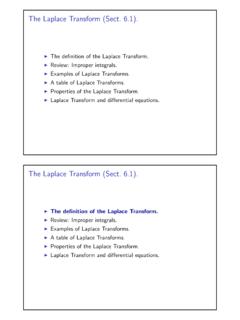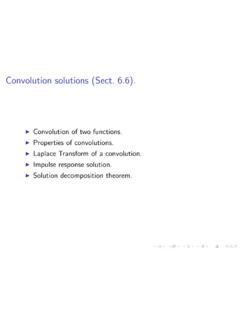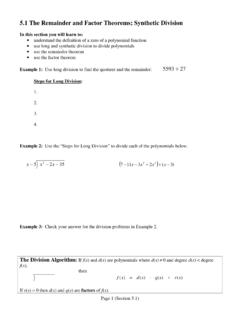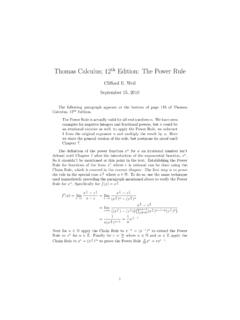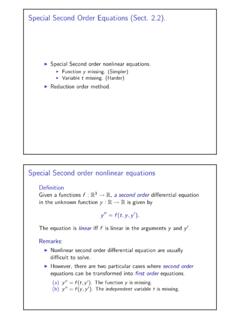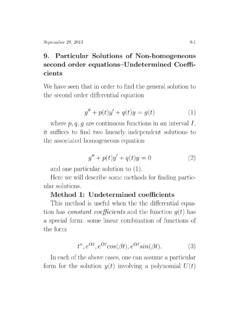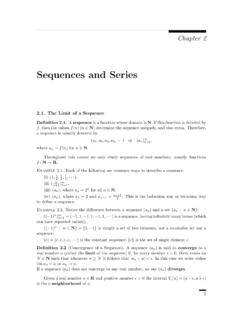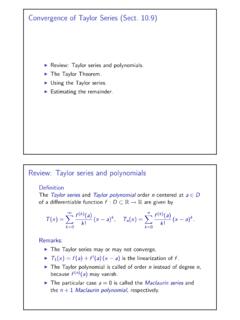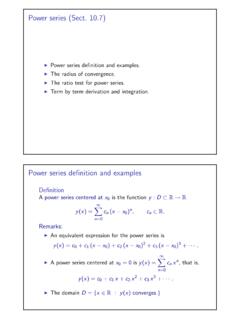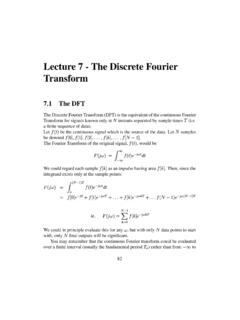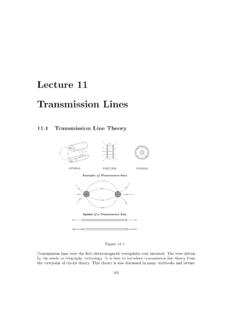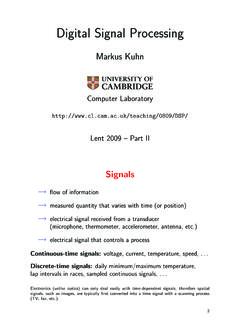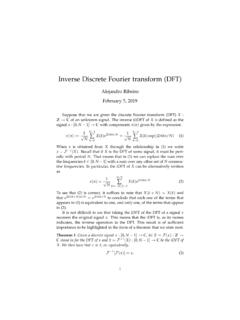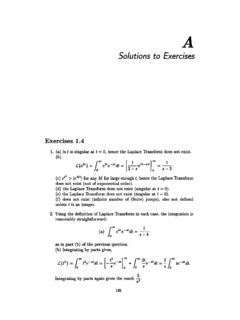Transcription of ORDINARY DIFFERENTIAL EQUATIONS
1 ORDINARY DIFFERENTIAL EQUATIONSGABRIEL NAGYM athematics Department,Michigan State University,East Lansing, MI, 16, is an introduction to ORDINARY DIFFERENTIAL EQUATIONS . We describe themain ideas to solve certain DIFFERENTIAL EQUATIONS , like first order scalar EQUATIONS , secondorder linear EQUATIONS , and systems of linear EQUATIONS . We use power series methodsto solve variable coefficients second order linear EQUATIONS . We introduce Laplace trans - form methods to find solutions to constant coefficients EQUATIONS with generalized sourcefunctions. We provide a brief introduction to boundary value problems, Sturm-Liouvilleproblems, and fourier Series expansions.
2 We end these notes solving our first partialdifferential equation, the Heat Equation. We use the method of separation of variables,hence solutions to the partial DIFFERENTIAL equation are obtained solving infinitely manyordinary DIFFERENTIAL NAGY ODE August 16, 2015 IContentsChapter 1. First Order Linear Constant Coefficient Overview of DIFFERENTIAL Linear Linear EQUATIONS with Constant The Initial Value Linear Variable Coefficient Linear EQUATIONS with Variable The Initial Value The Bernoulli Separable Separable Euler Homogeneous Exact Exact DIFFERENTIAL Finding a Potential The Integrating Factor The Integrating Factor for the Inverse Exponential Newton s Cooling Salt in a Water Nonlinear The Picard-Lindel of Comparison Linear Nonlinear Direction Exercises63
3 Chapter 2. Second Order Linear Variable The Initial Value Homogeneous The Wronskian Abel s Reduction of Order Special Second Order Reduction of Order Homogeneous Constant Coefficients The Roots of the Characteristic Real Solutions for Complex Constructive proof of Theorem NAGY ODEaugust 16, Nonhomogeneous The General Solution The Undetermined Coefficients The Variation of Parameters Review of Constant Coefficient Undamped Mechanical Damped Mechanical Electrical Exercises111 Chapter 3. Power Series Solutions Near Regular Regular The Power Series The Legendre The Euler Equidimensional The Roots of the Indicial Real Solutions for Complex Transformation to Constant Solutions Near Regular Singular Regular Singular The Frobenius The Bessel Exercises146 Notes on Chapter 3147 Chapter 4.
4 The Laplace Transform Definition of the Laplace Review of Improper Definition and Main The Initial Value Solving DIFFERENTIAL One-to-One Partial Discontinuous Step Translation Solving DIFFERENTIAL Generalized Sequence of Functions and the Dirac Computations with the Dirac Delta182G. NAGY ODE August 16, Applications of the Dirac The Impulse Response Comments on Generalized Convolutions and Definition and The Laplace Solution Exercises196 Chapter 5. Systems of DIFFERENTIAL Linear DIFFERENTIAL First Order Linear Order The Initial Value Homogeneous The Wronskian and Abel s Constant Coefficients Diagonalizable Decoupling the Eigenvector solution Alternative solution Non-homogeneous Two-by-Two Constant Coefficients The diagonalizable Non-diagonalizable Two-by-Two Phase Real distinct Complex Repeated Non-Diagonalizable Systems241 Chapter 6.
5 Autonomous Systems and Flows on the Autonomous A Geometric Population Growth Linear Stability Flows on the Linear Stability255 Chapter 7. Boundary Value Eigenvalue-Eigenfunction Comparison: IVP and Eigenvalue-eigenfunction Exercises265 IVG. NAGY ODEaugust 16, Overview of fourier Origins of fourier fourier Even and odd The Heat The Initial-Boundary Value The Separation of Exercises281 Chapter 8. Review of Linear Systems of Algebraic Linear algebraic Gauss elimination Linearly Matrix A matrix is a Matrix The inverse Diagonalizable Eigenvalues and Diagonalizable The exponential of a Exercises314 Chapter 9.
6 Appendices315 Appendix A. Review Complex Numbers315 Appendix B. Review of Power Series316 Appendix C. Review Exercises320 Appendix D. Practice Exams320 Appendix E. Answers to Exercises321 References330G. NAGY ODE August 16, Order EquationsWe start our study of DIFFERENTIAL EQUATIONS in the same way the pioneers in this field did. Weshow particular techniques to solve particular types of first order DIFFERENTIAL EQUATIONS . Thetechniques were developed in the eighteen and nineteen centuries and the EQUATIONS includelinear EQUATIONS , separable EQUATIONS , Euler homogeneous EQUATIONS , and exact this way of studying DIFFERENTIAL EQUATIONS reached a dead end.
7 Most of the differentialequations cannot be solved by any of the techniques presented in the first sections of thischapter. People then tried something different. Instead of solving the EQUATIONS they tried toshow whether an equation has solutions or not, and what properties such solution may is less information than obtaining the solution, but it is still valuable information. Theresults of these efforts are shown in the last sections of this chapter. We present Theoremsdescribing the existence and uniqueness of solutions to a wide class of DIFFERENTIAL 20 2y = 2 cos(t) cos(y)2G. NAGY ODEaugust 16, Constant Coefficient of DIFFERENTIAL DIFFERENTIAL equation is an equation, theunknown is a function, and both the function and its derivatives may appear in the equa-tion.
8 DIFFERENTIAL EQUATIONS are essential for a mathematical description of nature, becausethey are the central part many physical theories. A few examples are Newton s and La-grange EQUATIONS for classical mechanics, Maxwell s EQUATIONS for classical electromagnetism,Schr odinger s equation for quantum mechanics, and Einstein s equation for the general the-ory of gravitation. In the following examples we show how DIFFERENTIAL EQUATIONS look like.(a)Newton s Law:ma=f, mass times acceleration equals force. Newton s second lawof motion for a single particle is a DIFFERENTIAL equation. The unknown is the position ofthe particle in space,x(t), at the timet.
9 This is a single variable vector-valued functionin space. In another words,x:R R3, wherexis a function with domainRand rangeR3. The DIFFERENTIAL equation ismd2xdt2(t) =f(t,x(t)),where the positive constantmis the mass of the particle,d2x/dt2is the acceleration ofthe particle, andf:R R3 R3is the force acting on the particle, which depends onthe timetand the position in spacex.(b)Radioactive Decay:In the time decay of a radioactive substance the unknown is ascalar-valued functionu:R R, whereu(t) is the concentration of the radioactivesubstance at the timet. The DIFFERENTIAL equation isdudt(t) = k u(t),wherekis a positive constant.
10 The equation says the higher the material concentrationthe faster it decays.(c)The Wave Equation:The wave equation describes waves propagating in a media. Anexample is sound, where pressure waves propagate in the air. The unknown is a scalar-valued function of two variablesu:R R3 R, whereu(t,x) is a perturbation in theair density at the timetand pointx= (x,y,z) in space. (We used the same notationfor vectors and points, although they are different type of objects.) The equation is ttu(t,x) =v2[ xxu(t,x) + yyu(t,x) + zzu(t,x)],wherevis a positive constant describing the wave speed, and we have used the notation to mean partial derivative.
